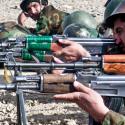 |
 |
10,000 Troops In Afghanistan Is Not Enough: Rightsizing NATO’s Developmental Support Force Beyond 2014

This is the second paper in a series on Afghan National Army development and transition.
The Afghan National Army (ANA) is arguably the most respected institution in Afghanistan. Keeping it that way as it becomes more self-sufficient will contribute to all of NATO’S post-2014 strategic aims: improving governmental legitimacy and creating an environment for economic progress and reconciliation, as well as continuing counter-terrorist operations within Afghanistan and the region. NATO political and military leaders should be brutally honest with themselves as to the actual requirement associated with ANA development beyond 2014, and they must avoid a dangerous pitfall endemic in this kind of decision. Maintaining the ANA’s positive developmental trajectory is a necessary component to both NATO’s and America’s post 2014 strategy.
The size of the force NATO tasks with the responsibility to continue the ANA’s positive trajectory should be the conclusion of two extensive dialogues. The first determines the “objective” requirement. This discussion is not unconstrained; rather, it is limited by the overall strategic aims and the specific tasks associated with ANA developmental. The second dialogue is a discussion of the risks leaders are willing to take if a less than the “objective” requirement is fielded. These are related, but distinct, discussions. Without the outcome of the first dialogue, the second will not be grounded upon battlefield realities, so adequate risk assessments become near impossible. The combined purpose of the two dialogues is to avoid the extremes of too much and too little.
But there is danger associated with the dialogue process itself. Assumptions about what is “politically feasible,” how much risk can be taken, and what force is required may shape the objective discussion of force requirements. We can appear to have a dialogue without actually doing so. This kind of skewed approach is dangerous, for it wastes lives and money by fielding a force that cannot accomplish its assigned task.
The objective requirements for the ANA’s post 2014 development should derived from the answers to four basic questions. First, will any of the ANA units have partner NATO units or will the developmental effort be executed solely through a set of embedded developers? Second, if NATO uses only embedded teams, at what levels and in which units will these teams be employed? Third, what kind of headquarters will be necessary to coordinate these efforts? Finally, what direct support—combat support (intelligence, lift and medical evacuation aviation, medical, and air and ground fires) and combat service support (supply, maintenance, ground transport, and logistics)—must be available to the ANA as well as to NATO’s embedded development teams?